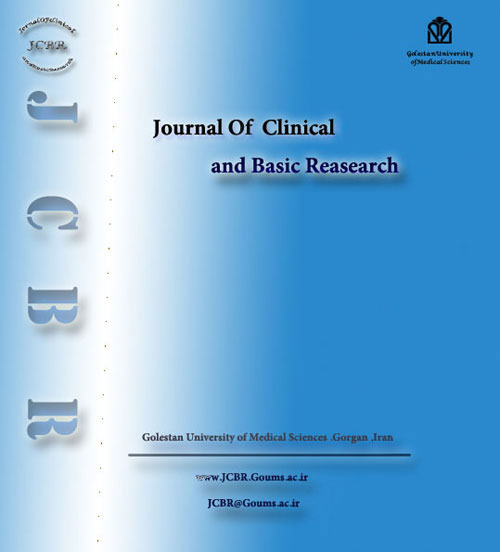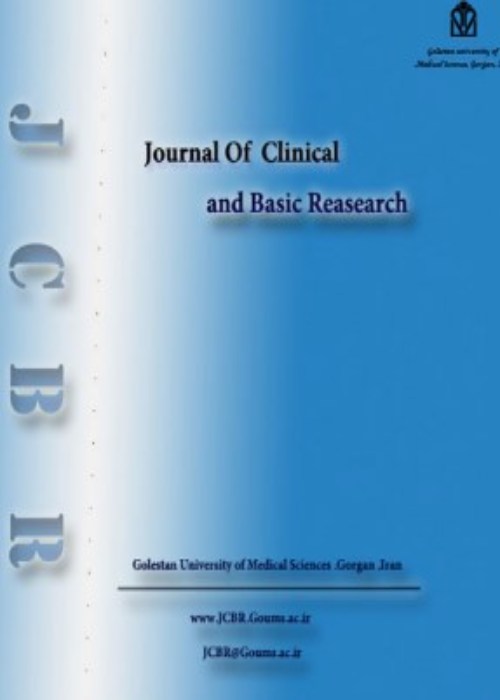فهرست مطالب

Journal of Clinical and Basic Research
Volume:3 Issue: 4, Autumn 2019
- تاریخ انتشار: 1398/09/10
- تعداد عناوین: 5
-
Pages 1-6Background and objectives
Bladder filling and severe urgency to urinate may affect the cardiovascular system through viscero-visceral reflexes. In the cardiovascular system, post-micturition syncope is a well-known and clinically important consequence of this phenomenon. Despite the importance of such reflexes, limited numbers of studies have investigated the in vivo effects of bladder filling on the heart. The purpose of this study was to determine the effects of bladder filling through water ingestion on heart rate and the autonomic nervous system in healthy young men.
MethodsThis was a descriptive-analytical study performed on 20 healthy male volunteer students. Five minutes after voluntary bladder emptying, the electrodes were attached and heart rate was recorded in the sitting position in a controlled environment. After five minutes of adjustment, data collection was started at 1 KHz sampling frequency. Then, the participants continued drinking water until developing severe urgency to urinate. Heart rate was recorded at the peak of urgency and the data were compared with baseline values. All data were expressed as mean ± standard deviation. Statistical analyses of data were performed using SPSS 16 at significance level of 0.05.
ResultsMean age, weight and height of the participants were 22.3 ± 3.466 years, 75.55 ± 15.5 kg and 175.8 ± 11.28 cm, respectively. Mean heart rate was 74±12.23 after the initial urination, 68.55±10.53 when feeling severe urgency to urinate and 66.3±10.87 after the second urination. The heart rate differed significantly between the three tested conditions (P<0.05). There was no significant difference in other parameters of heart rate variation including SDNN, RMSSD, RRM, PNN50, absolute and relative (normalized) low frequency and high frequency and their ratio (LF/HF).
ConclusionBladder distension secondary to drinking water has no effect on the heart autonomic balance.
Keywords: Bladder distension, Heart, Autonomic nervous system -
Pages 7-12Background and objectives
Pregnancy is one of the most important and stressful periods of women's lives. Recent studies have indicated an increasing trend in caesarean section rates. Although women are becoming more impatient and less resilient about vaginal delivery, raising awareness on stress management and resilience increases women’s readiness for the important task of motherhood. The purpose of this study was to investigate effect of an accompanying midwife on maternal resilience and preferred method of delivery in pregnant women.
MethodsThis cross-sectional, descriptive-analytical study was performed on pregnant women who were in the final month of pregnancy and referred to the Khatam-al-Anbia and Baghiyyatollah al-Azam hospitals in Tehran (Iran) for periodic examinations in 2018. Overall, 150 pregnant women (75 with an accompanying midwife and 75 without an accompanying midwife) were selected using simple random sampling. The Connor-Davidson Resilience Scale was used to assess maternal resilience. In addition, the delivery preference (natural childbirth or cesarean section) was determined in the scale. Data were analyzed in SPSS 16 using descriptive statistics and inferential statistics at significance level of 0.05.
ResultsPregnant women with an accompanying midwife had a significantly higher mean resilience score than those without an accompanying midwife (P=0.002). Moreover, the resilience score had a significant impact on subjects’ preferred route of delivery (P <0.01).
ConclusionThe findings of this study show that pregnant women accompanied by a midwife during pregnancy have better resilience and tendency towards vaginal delivery.
Keywords: Resilience, accompanying midwife, vaginal delivery, caesarean section -
Pages 13-22
Since their discovery, non-coding RNAs have been known as key regulators of gene expression. Gaining a better understanding about their biogenesis and function may provide valuable knowledge about the heterogeneity of malignancies and contribute to identification of diagnostic, prognostic and therapeutic targets. Long non-coding RNAs (lncRNAs) are a group of RNAs composed of >200 nucleotides that play important regulatory roles in gene transcription, splicing and epigenetics as well as in biological processes involved in cell cycle, development and pluripotency. Generally, the expression levels of lncRNAs are lower than protein-coding genes, but they exhibit more tissue-specific expression patterns. Recent studies have suggested involvement of cancer-specific lncRNAs including HOTAIR, ANRIL, FENDRR, GAS5 and H19 in tumorigenesis, tumor cell proliferation, invasion, migration, apoptosis and angiogenesis. Expression of lncRNAs is tissue-specific and may vary depending on the stage of tumor progression. In this review, we summarize current knowledge on the roles of lncRNAs in some cancers and their potential as diagnostic and prognostic targets.
Keywords: Cancer, lncRNA, Biomarkers -
Pages 23-30Background and objectives
Obesity has become a global epidemic. Previous studies have reported a relationship between obesity in adults and socioeconomic factors, but the results regarding such relationship in the case of childhood obesity have been inconsistent. Therefore, this study aimed to determine the relationship between socioeconomic inequalities and overweight/obesity in children.
MethodsAll meta-analysis, systematic and descriptive or correlational reviews on obesity in children and adolescents that have been published in English between January 2001 and January 2019 were included in the study. We performed the search for articles in the following databases: MEDLINE, Embase, Web of Science, Cochrane Library and Google Scholar. Each review article was subjected to qualitative evaluation using the Grading of Recommendations Assessment, Development and Evaluation (GRADE) tool.
ResultsOf 46 articles that met the inclusion criteria, five systematic reviews were included after carefully reading the abstract and the full text of the articles. The prevalence of overweight and obesity in children differed in different socioeconomic groups. Ethnicity was a confounding factor that could change this relationship.
ConclusionStrong evidence supports the relationship between socioeconomic status and overweight or obesity in children. Therefore, it is recommended to consider the socioeconomic status when planning for control and prevention of childhood obesity.
Keywords: Inequality, socioeconomic, obesity, children -
Pages 31-36Background and objectives
Pre-hospital emergency medical services (EMS) personnel are responsible for transferring patients. In case of improper patient handling, these individuals become vulnerable to various musculoskeletal problems including back pain. In this study, we aimed to evaluate the impact of an eight-hour training intervention about patient handling and transfer ergonomics on low back pain in pre-hospital EMS personnel working in the Golestan Province, Iran.
MethodsThis was a quasi-experimental study with a pre-test/post-test design. The study population consisted of 200 pre-hospital EMS personnel working in the Golestan Province, Iran. Overall, 40 EMS personnel were eligible to participate in the study. Data were collected using a demographic questionnaire, the Oswestry low back pain disability questionnaire and the Quebec back pain disability scale. The eight-hour training session was held by a research nurse, a physiotherapist and a physician. The subjects recompleted the Oswestry low back pain disability questionnaire and the Quebec back pain disability scale at baseline, four weeks and 12 weeks post-intervention. The collected data were analyzed using SPSS 16 and descriptive statistics.
ResultsThe mean age, body mass index and work experience was 38.6 ± 7.6 years, 25.9 ± 3.5 kg/m2 and 8.27± 5.2 years, respectively. The mean score of functional disability reduced significantly from 35.9 ± 9 at baseline to 27.5 ± 2.5 and 19.6 ± 7 four weeks and 12 weeks after the intervention, respectively (P=0.0001). Furthermore, the mean pain score decreased from 38.7 ± 13.86 to 31.05 ± 10.75 one month post-intervention and to 22.4 ± 9.47 three months post-intervention (P=0.0001).
ConclusionOur findings suggest that training intervention on ergonomic patient transfer and patient handling can reduce the rate of lower back pain in pre-hospital EMS personnel.
Keywords: Education, Patient transfer, Low Back Pain, Pre-hospital Emergency


